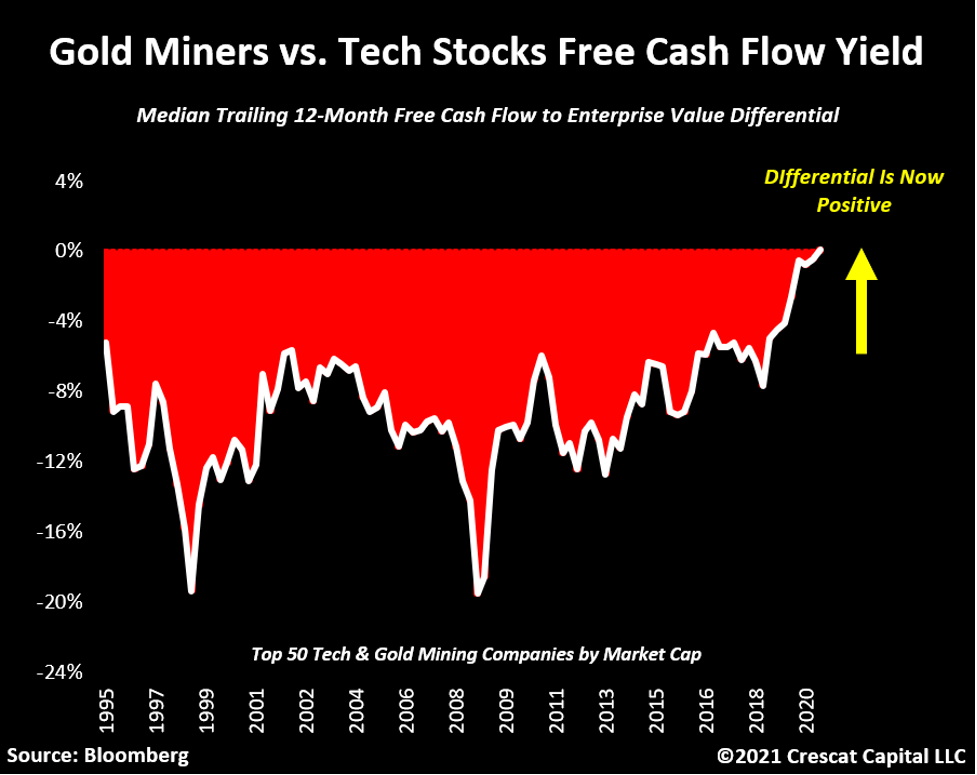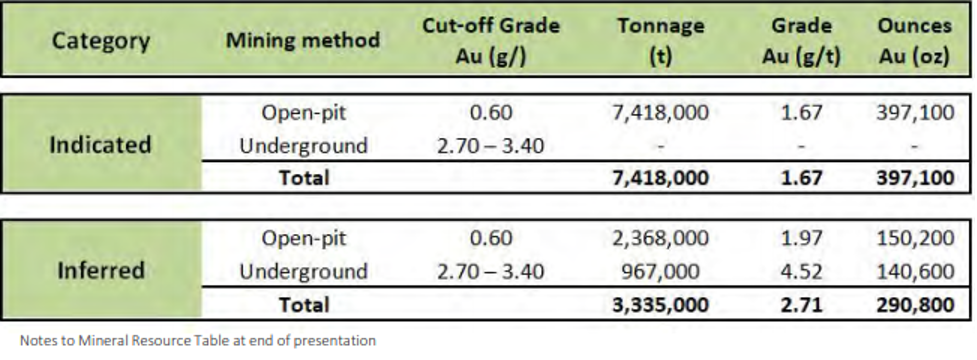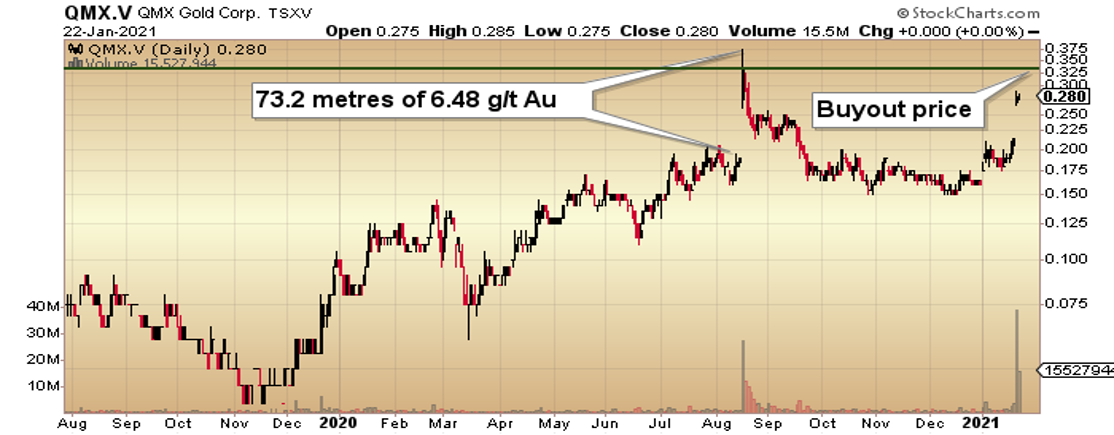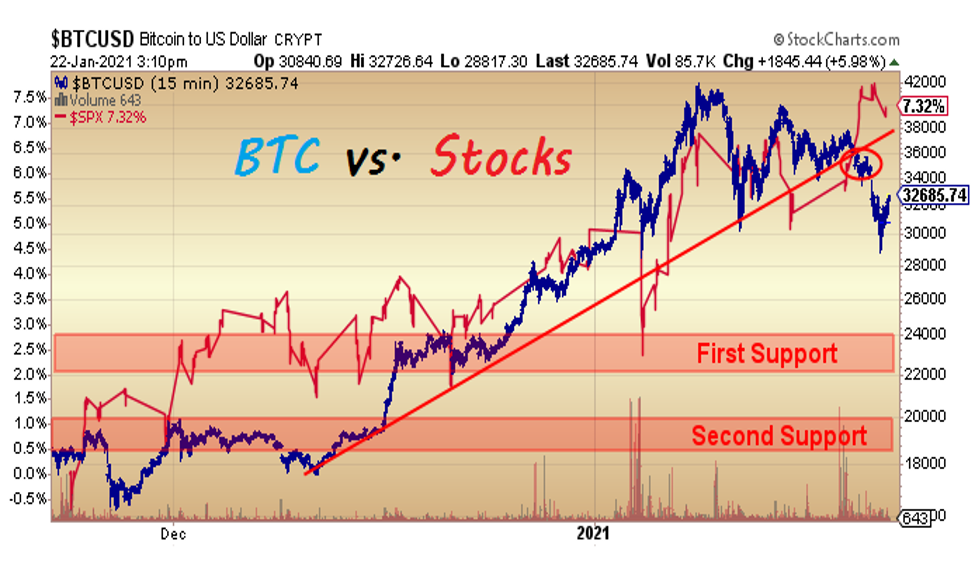Shenanigans Abound: Gold, Silver and Cryptocurrency
 Sector expert Michael Ballanger explores the generational trends currently shaping investment markets, including the precious metals.
Sector expert Michael Ballanger explores the generational trends currently shaping investment markets, including the precious metals.

Listening to a particularly popular "weekly wrap-up" (featuring a gold perma-bull and a certain prominent billionaire's "favorite technical analyst") last Saturday afternoon, I was immediately struck by the reversal in the analyst's so-called "technical picture" for gold and silver, because it was only two weeks ago that "silver looks great" and "gold is biding its time" (or something like that). Instead, he now does not like the gold or silver miners and thinks both are headed lower, but that Bitcoin is headed "to $36,000 then $54,000" as part of the final blowoff in its "parabolic ascent."
So, if I were to follow his line of reasoning, you want to take a bullish trading posture to the most speculative bubble in history while avoiding the asset class with 5,000 years of utility and history that is currently in a long-term bull market, but is dangerous because it is 12.29% off the all-time highs seen in August 2020.
Herein lies the difficulty in basing 100% of your investment decisions on any one form of analysis. Fundamentalists tend to ignore the predictive power of price patterns and other quantitative data that can often reveal changes in the flow of capital to and from the precious metals sector. Technicians, by contrast, tend to focus purely on short-term signals that choose to ignore fundamental changes in macroeconomic trends, or in either fiscal or monetary policy by those in charge.
When both fundamental and technical analyses are blended, in a perfect world, the result is a beautiful canvas of analytical brushstrokes producing a world-class roadmap of the future direction and amplitude of a stock's next move. However, in reality, what often results is a dog's breakfast of conflicting signals and omens, leaving the investor both confused and disillusioned.
Gold and silver mining stocks are today a textbook example of this dichotomy of portent with low input costs, such as energy and cost of capital, aligning with near-record pricing structures to produce profit-margin windfalls throughout the entire sector. Fundamental analysts like Fred Hickey and Pierre Lassonde are beating the "undervaluation" drums with ecumenical enthusiasm, yet such fervor is being met with abject disdain by those managing large portfolios, because price the final arbiter of investment acumen refuses to pay heed to such pulpit preaching by counters of beans.
Here is a favorite graph making the rounds in the precious metals blogosphere. It is a comparison of free cash flow between the gold miners and the tech stocks. It suggests by way of inference that the legions of Gen-Z, Millennial, and Gen-X investors make their investment decisions based upon "informational tripe" such as this. For the past year, and certainly since early August, stimulus checks have been allocated to owning tech, which these kiddies not only understand but also worship due to the generational obsession with all things digital.

Not having been schooled in the history of hyperinflation over the past 5,000 years, this new breed of youthful investors soar from one name to another and from sector to sector like flocks of swallows chasing insects in the swamp at dusk, large arching ascents followed by near vertical dives in hunt of their buzzing prey. I assure you; gold and silver are not on their menus.
The yellow highlighted portion in the graph above means nothing to the stewards of these large capital pools; if their social media feed, like Twitter or Instagram, told them to buy into asteroid mining, they would gladly re-tweet the narrative until the desired effect was achieved. A great example of this was when the Robinhooders took bankrupt Eastman Kodak from $2 to $60 in a 72-hour period, only to succumb to gravity (as opposed to common sense or sanity), and crash back down to $6.
Alas, 90% drawdowns are meaningless when the investor is using government handouts to play the game as opposed to four years of summer job savings or rent money.
The problem facing investors born before 1977 is that the rules of investment engagement have been altered to the point where the scales are tilted in favor of price at the detriment of value. For the older generations, gratification and reward for any endeavor was a process that took time to achieve. Mid-semester school projects involved hours at the library versus minutes on the internet, while shopping for the best refrigerator took multiple store visits over weeks rather than a lunch hour online. Patience is now a lost art form, while instant gratification a God-given right. Investment rewards for the younger generations involve daily tabulations of price versus monthly or yearly assessments of value and this is precisely why we are faced with this maddening dichotomy in the gold and silver miners.
Which brings me to the point of the exercise what will snap these markets back to the proper balance between value and price?
The answer lies in that old adage that "the best cure for high prices is high prices," because in a free market economy (remember that?), high prices attract new supply as manufacturers retool and rebrand in search of that demand which is creating those high prices. Conversely, low prices discourage new entrants to the market and force existing suppliers elsewhere, which eliminates excess supply after which price rebalances.
High stock prices in the technology space have persisted because the demand for them has been fueled by cheap money and government subsidies. Without subsidies, Tesla would be toast. Without the bailouts in 2008, half the global financial behemoths would be either gone or massively restructured under new ownership. If the U.S. 10-year were back at 9%, as in 1994, competition for return especially risk-adjusted return would siphon money away from stocks and into bonds. However, government intervention has minimalized the perception of risk and made it perennially safe to invest in stocks and bonds, but unsafe to speculate in gold or silver. Note the difference in terminology invest versus speculate.
Larry Summers, Treasury secretary under Bill Clinton, was a huge proponent of "behavioral finance," and believed that stock price movements had a huge impact on consumer behavior. The "asymmetrical wealth effect," defined as the impact of inflating assets, such as housing and stocks, upon spending habits, has long been viewed with overt reverence by the politico-banco elite. But what was once a beneficial barometer of a booming economy is now seen as the temperature of a booming economy. This is why government intervention is so ardently "pro-stocks" and "anti-gold" because it violates the mantra long preached by the elite.

There is another competitor in the arena that is threatening to dethrone stocks and while in the last three decades it was precious metals donning the black hat of the enemy, cryptocurrencies are now the enemy. The initial line of defense has been central bank threats to launch their own digital currencies but the crypto-advocates have thus far soundly rejected any notion of that being successful. When the politico-banco criminals decide to shut down crypto, and I firmly believe that they will, those wishing to control their wealth away from the watchful, covetous eye of Big Brother will finally recognize that "possession is nine-tenths of the law," and storing wealth in a digital vault is a far cry removed from having it in your home within spitting distance of your Smith & Wesson.
For value-seekers to finally begin to dominate price-chasers, the central bank lifeline must be terminated either by the impact of high prices or by the final acceptance that stock prices are no longer impacting consumer behavior. Once that happens, capital flows will gravitate toward value because prices no longer manipulated by the elite can no longer be trusted. When price-chasers finally become value-seekers, companies producing products cheaply while commanding high prices will increase in value until they are no longer attractive. The key will be the sheer volume of dollars, euros, yen and renminbi migrating from price-chasing to value-seeking, and when that occurs, owners of gold and silver and their equity market brethren will soar.
Gold and silver miners are today generating historic profits and while high prices are most certainly going to attract more supply, that supply can only arrive from the developers. As an example of the value proposition, I want to take you to the announcement last week of the "friendly" acquisition by Eldorado Gold Corp. (ELD:TSX; EGO:NYSE) (US$11.13/share) of junior explorer/developer QMX Gold Corp.(QMX:TSX.V/QMXGF: OTC)(CA$0.28/US$0.22) for the approximate sum of CA$132 million in cash and stock.

The graphic shown above demonstrates the indicated and inferred ounces at 687,900 present in the Bonnefond Deposit, located in Val-d'Or, Quebec, adjacent to the Lamaque Mine currently operated by Eldorado.

While there are numerous other discovery zones present in the QMX land package, EGO paid US$150.63 per ounce to acquire QMX, which appears quite generous at first glance, but when you go through the corporate presentation for QMX, it is obvious that there are a great many more ounces situated within their property boundaries. However, it hammers home a point I have been making for the better part of a year, and that is that developers such as Getchell Gold Corp. (GTCH:CSE) are going to viewed as equally as attractive when the scale of the mineralized envelope at Fondaway is revealed by way of the 2021 drilling program.
The initial news releases referred to QMX as a " Val-d'Or explorer," which is why they sold off EGO on the news, but this type of merger and acquisition (M&A) activity is what I expect to see accelerating in 2021, and it plays favorably into the future for the GGMA portfolio, which is overweight developers/explorers in expectation of this incoming tsunami of mergers and buyouts.
I do not usually make it my practice of subscribing to other newsletters but one I absolutely deem as "required reading" is anything put out by Grant Williams, and that means podcasts, interviews or his newsletter. This weekend I listened to his interview with legendary hedge fund manager Paul Singer, who has been described as "one of the toughest and smartest in the hedge fund industry." It was an "eye-opener" to say the least, and even though I am resolute in my adherence to self-imposed investment rules, I still from time to time require a dollop of morale boosting for a number of reasons, the most important being to maintain my sanity in the face of these gargantuan dislocations in valuations, which exist everywhere you run into central bank fingerprints.
At the end of the day, no amount of bullion bank shenanigans is going to alter the final replacement cost of an ounce of gold or silver when the unit of payment is a depreciating currency. Show me one currency in circulation anywhere that is practicing sound money principles and I will choose it over gold or silver. The reality is that with this global pandemic still shuttering economic activity, global currency debasement is universal.

Originally posted on Saturday, Jan. 23.
Follow Michael Ballanger on Twitter @MiningJunkie.
Originally trained during the inflationary 1970s, Michael Ballanger is a graduate of Saint Louis University where he earned a Bachelor of Science in finance and a Bachelor of Art in marketing before completing post-graduate work at the Wharton School of Finance. With more than 30 years of experience as a junior mining and exploration specialist, as well as a solid background in corporate finance, Ballanger's adherence to the concept of "Hard Assets" allows him to focus the practice on selecting opportunities in the global resource sector with emphasis on the precious metals exploration and development sector. Ballanger takes great pleasure in visiting mineral properties around the globe in the never-ending hunt for early-stage opportunities.
[NLINSERT]Disclosure:
1) Michael J. Ballanger: I, or members of my immediate household or family, own securities of the following companies mentioned in this article: Getchell Gold, Eldorado Gold. My company has a financial relationship with the following companies referred to in this article: Getchell Gold . I determined which companies would be included in this article based on my research and understanding of the sector. Additional disclosures are below.
2) The following companies mentioned in this article are billboard sponsors of Streetwise Reports: None. Click here for important disclosures about sponsor fees. As of the date of this article, an affiliate of Streetwise Reports has a consulting relationship with Getchell Gold. Please click here for more information.
3) Statements and opinions expressed are the opinions of the author and not of Streetwise Reports or its officers. The author is wholly responsible for the validity of the statements. The author was not paid by Streetwise Reports for this article. Streetwise Reports was not paid by the author to publish or syndicate this article. Streetwise Reports requires contributing authors to disclose any shareholdings in, or economic relationships with, companies that they write about. Streetwise Reports relies upon the authors to accurately provide this information and Streetwise Reports has no means of verifying its accuracy.
4) This article does not constitute investment advice. Each reader is encouraged to consult with his or her individual financial professional and any action a reader takes as a result of information presented here is his or her own responsibility. By opening this page, each reader accepts and agrees to Streetwise Reports' terms of use and full legal disclaimer. This article is not a solicitation for investment. Streetwise Reports does not render general or specific investment advice and the information on Streetwise Reports should not be considered a recommendation to buy or sell any security. Streetwise Reports does not endorse or recommend the business, products, services or securities of any company mentioned on Streetwise Reports.
5) From time to time, Streetwise Reports LLC and its directors, officers, employees or members of their families, as well as persons interviewed for articles and interviews on the site, may have a long or short position in securities mentioned. Directors, officers, employees or members of their immediate families are prohibited from making purchases and/or sales of those securities in the open market or otherwise from the time of the interview or the decision to write an article until three business days after the publication of the interview or article. The foregoing prohibition does not apply to articles that in substance only restate previously published company releases. As of the date of this article, officers and/or employees of Streetwise Reports LLC (including members of their household) own securities of Getchell Gold, a company mentioned in this article.
Michael Ballanger Disclaimer: This letter makes no guarantee or warranty on the accuracy or completeness of the data provided. Nothing contained herein is intended or shall be deemed to be investment advice, implied or otherwise. This letter represents my views and replicates trades that I am making but nothing more than that. Always consult your registered advisor to assist you with your investments. I accept no liability for any loss arising from the use of the data contained on this letter. Options and junior mining stocks contain a high level of risk that may result in the loss of part or all invested capital and therefore are suitable for experienced and professional investors and traders only. One should be familiar with the risks involved in junior mining and options trading and we recommend consulting a financial adviser if you feel you do not understand the risks involved.